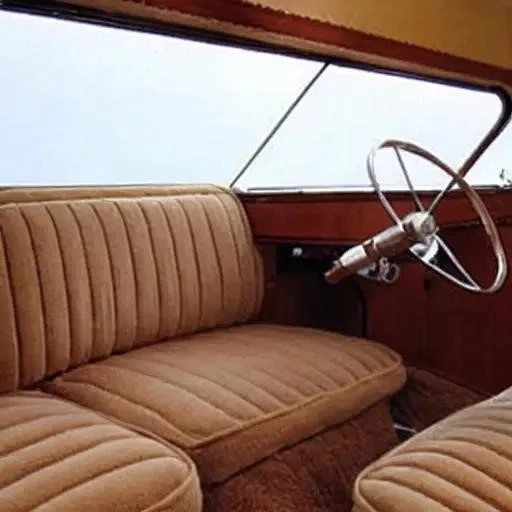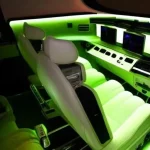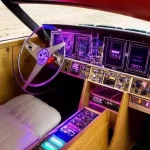Step into a time machine, not to revisit the past, but to understand the future. The 1960s, an era synonymous with audacious design, cultural shifts, and a profound sense of optimism, didn’t just give us iconic external automotive shapes; it birthed interior aesthetics that continue to subtly, yet powerfully, shape our modern driving experiences. From the sleek lines of a Mustang to the whimsical charm of a VW Beetle, the ’60s car interior wasn’t merely a functional space; it was a vibrant statement, a canvas reflecting an entire generation’s aspirations and technological marvels, however nascent. This deep dive reveals how these vintage cabins, far from being dusty relics, are remarkably inspiring contemporary design philosophies, pushing boundaries in comfort, connectivity, and sheer stylistic bravado.
Peering through the rearview mirror, one instantly grasps the era’s unique blend of exuberance and nascent futurism. Designers of the time, unfettered by today’s stringent safety regulations and complex digital interfaces, reveled in material innovation and bold color palettes. They envisioned interiors as extensions of personal style, spaces for adventure, and cocoons of comfort, crafting environments that felt both futuristic and profoundly human. This forward-thinking approach, married with an intuitive understanding of user experience, remains a compelling blueprint for automotive creatives grappling with the complexities of autonomous vehicles and increasingly personalized cabins. By integrating insights from this golden age, designers are rediscovering the magic of thoughtful, engaging interior spaces, proving that sometimes, the path forward is paved with lessons from the past.
Key Design Elements of 1960s Car Interiors
For a clearer understanding of the profound influence of this era, consider the defining characteristics that made ’60s automotive interiors so distinctive:
| Category | Key Characteristics/Elements | Modern Influence/Relevance |
|---|---|---|
| Design Philosophy | Optimism, Space Age Futurism, Driver-Centric Experience, Expressive Styling | Focus on user experience, emotional connection, and brand identity in modern design. |
| Dominant Materials | Vibrant Vinyl, Chrome Accents, Patterned Fabrics, Faux Woodgrain, Hard Plastics | Resurgence of tactile materials, sustainable alternatives, and bold color blocking. |
| Iconic Features | Bucket Seats, Center Consoles, Push-Button Radios, Ribbon Speedometers, Generous Use of Color | Ergonomic seating, integrated infotainment, intuitive controls, personalized ambient lighting; |
| Ergonomics & Comfort | Emphasis on plush seating, ample legroom, intuitive placement of essential controls (for the era). | Advanced seat adjustability, smart storage solutions, focus on holistic well-being. |
| Technological Integration | Early AC, Power Windows, AM/FM Radios, Basic Information Displays (e.g., fuel gauge, clock) | Seamless digital integration, voice controls, advanced driver-assistance systems (ADAS). |
| Reference Link | Classic Motorsports: An Inside Look at ’60s Interiors | |
The allure of ’60s interiors extends far beyond mere nostalgia; it’s about a design ethos that celebrated individual expression and a boundless future. Imagine sitting in a 1967 Cadillac Eldorado, its plush velour seats cradling you, the dashboard a sweeping arc of chrome and simulated wood, punctuated by elegant dials. This wasn’t just transportation; it was an event, a statement of arrival. This unapologetic embrace of luxury and distinctive style is incredibly effective in differentiating brands today, challenging the minimalist, screen-dominated cabins that sometimes feel indistinguishable across manufacturers. Modern designers are now consciously seeking to reintroduce character and warmth, recognizing that a truly compelling interior sparks joy and fosters a deeper connection with the vehicle.
Moreover, the ’60s pioneered a certain driver-centricity, even if the tools were analog. Controls were generally large, clearly labeled, and positioned for easy access, fostering a sense of command over the machine. This focus on intuitive interaction, albeit through physical buttons and levers, offers invaluable lessons for an age grappling with the potential distractions of touchscreens and complex menus. By integrating AI-driven insights with the simplicity of ’60s design principles, we can create future interiors that are both technologically advanced and profoundly user-friendly, offering drivers and passengers a harmonious blend of control and convenience. Consider the enduring popularity of retro-styled elements in concept cars, a testament to the powerful resonance of this era’s design language.
Industry experts often point to the daring material choices of the ’60s as a significant source of inspiration. The decade saw an explosion of vibrant vinyls, daring patterned fabrics, and innovative plastics, allowing for previously impossible shapes and textures. This experimentation freed designers from traditional constraints, enabling them to sculpt interiors that were both visually striking and surprisingly durable. Today, as manufacturers explore sustainable materials like recycled plastics, plant-based leathers, and innovative composites, the spirit of ’60s material innovation encourages a similar boldness. We are witnessing a renaissance of textures and colors, moving away from monochrome palettes towards interiors that are rich, inviting, and uniquely personalized, reflecting a desire for authenticity and environmental consciousness.
Looking ahead, the legacy of the ’60s car interior will undoubtedly continue to illuminate the path forward for automotive design. As autonomous technology promises to transform cars into mobile living spaces, the emphasis on comfort, aesthetics, and personalized experience will only intensify. The optimistic vision encapsulated within those vintage cabins—a belief in progress, a celebration of individual style, and a yearning for adventure—provides a timeless framework. Designers, by thoughtfully reinterpreting these foundational principles, are not just creating beautiful cars; they are crafting the future of mobility, ensuring that tomorrow’s journeys are as engaging, comfortable, and memorable as those iconic rides of half a century ago. The road ahead, brilliantly illuminated by the past, promises an exciting evolution in automotive interior design, where innovation meets enduring charm.






